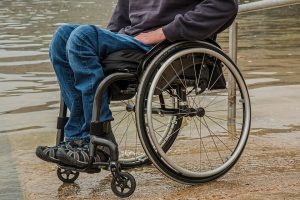Several neuromodulatory strategies have been used to improve leg function in individuals with spinal cord injury. These strategies include: electrical stimulation of the lumbar spinal cord (Harkema et al. 2011), operant conditioning of spinal reflexes (Thompson et al. 2013), and magnetic stimulation of a part of the brain that controls leg movements (Kumru et al. 2010) – either as sole treatments or in combination with rehabilitative exercise. However, improvements in motor function from these techniques have been limited and more effective techniques are needed.

One promising technique, called paired corticospinal-motoneuronal stimulation, involves the combined use of electrical stimulation of the peripheral nerve in the leg with transcranial magnetic stimulation of the part of the brain that controls the leg. This technique can induce neural plasticity. It can strengthen the neural connections in the spinal cord and acutely enhance the strength of muscles of the arm (Taylor and Martin 2009; Bunday and Perez 2012).
In our recent study (Urbin et al. 2017), we tested if this technique can be used to improve leg function in spinal cord injury. Our study involved 18 individuals with anatomically incomplete spinal cord injury and 23 individuals without spinal cord injury. We used a stimulation paradigm that lasted approximately 30 minutes and involved 200 pairs of stimuli. Importantly, during our paradigm, we timed the descending volleys from transcranial magnetic stimulation to arrive at the spinal cord shortly before the ascending volleys from peripheral nerve stimulation of the leg.
WHAT DID WE FIND?
We found that paired corticospinal-motoneuronal stimulation increased muscle activity of the tibialis anterior in individuals with and without spinal cord injury. The technique also increased the force output of the muscles involved in dorsiflexion of the foot. In some individuals, these effects lasted for one hour.
SIGNIFICANCE AND IMPLICATIONS
The results from our study indicate that paired corticospinal-motoneuronal stimulation can enhance muscle activity and voluntary force in dorsiflexor muscles in individuals with and without spinal cord injury, and the timing of the paired stimuli was a critical factor for inducing these changes. We believe this form of stimulation can be used to improve leg function in individuals with motor impairments.
PUBLICATION REFERENCE
Urbin MA, Ozdemir RA, Tazoe T, Perez MA. Spike-timing-dependent plasticity in lower-limb motoneurons after human spinal cord injury. J Neurophysiol 118, 2171 -2180, 2017.
If you cannot access the paper, please click here to request a copy.
KEY REFERENCES
Bunday KL, Perez MA. Motor recovery after spinal cord injury enhanced by strengthening corticospinal synaptic transmission. Curr Biol 22: 2355–2361, 2012.
Harkema S, Gerasimenko YP, Hodes J, Burdick J, Angeli C, Chen Y, Ferreira C, Willhite A, Rejc E, Grossman RG, Edgerton VR. Effect of epidural stimulation of the lumbosacral spinal cord on voluntary movement, standing, and assisted stepping after motor complete paraplegia: a case study. Lancet 377: 1938–47, 2011.
Kumru H, Murillo N, Samso JV, Valls-Sole J, Edwards D, Pelayo R, Valero-Cabre A, Tormos JM, Pascual-Leone A. Reduction of spasticity with repetitive transcranial magnetic stimulation in patients with spinal cord injury. Neurorehabil Neural Repair 24: 435–441, 2010.
Taylor JL, Martin PG. Voluntary motor output is altered by spike-timing-dependent changes in the human corticospinal pathway. J. Neurosci 29: 11708–716, 2009.
Thompson AK, Pomerantz FR, Wolpaw JR. Operant conditioning of a spinal reflex can improve locomotion after spinal cord injury in humans. J Neurosci 33: 2365-2375, 2013.
AUTHOR BIO
 Monica Perez, P.T., Ph.D. is an Associate Professor in the Department of Neurological Surgery at the University of Miami and The Miami Project to Cure Paralysis. She holds a secondary faculty position with the Department of Biomedical Engineering and Physical Therapy where she studies mechanisms involved in the control of movement in healthy humans and in individuals with spinal cord injury. You can learn more about Dr. Perez here.
Monica Perez, P.T., Ph.D. is an Associate Professor in the Department of Neurological Surgery at the University of Miami and The Miami Project to Cure Paralysis. She holds a secondary faculty position with the Department of Biomedical Engineering and Physical Therapy where she studies mechanisms involved in the control of movement in healthy humans and in individuals with spinal cord injury. You can learn more about Dr. Perez here.
